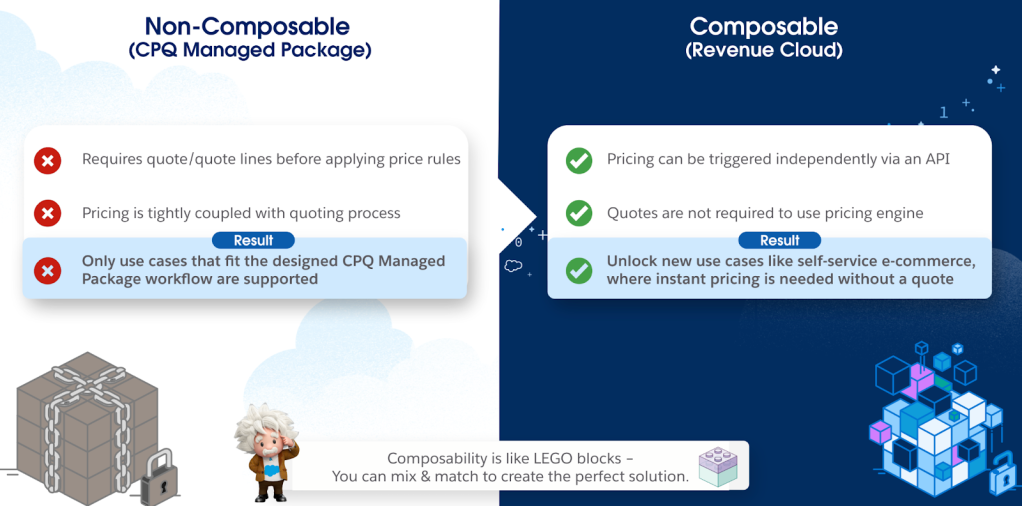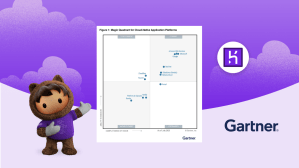RevOps is becoming more complex than ever, with hybrid monetization models, omni-channel sales, increasingly personalized customer journeys, and growing pressure for real-time, AI-powered decision-making.
But traditional quote-to-cash (QTC) software is falling short in several key areas, mainly because it wasn’t built for the pace, complexity, and intelligence required today. According to Deloitte, 71% of B2B executives struggle with manual, fragmented sales processes — and 13% of deals are lost because of disconnected tools.
Revenue Cloud is made for the hybrid world of today’s RevOps. It’s the industry’s first modular, composable, agentic RevOps platform. No longer do sales executives need to suffer through tedious workarounds that hold the QTC process hostage.
Agentic and API-first
Revenue Cloud has built-in agentic capabilities with Agentforce, Salesforce’s digital labor platform. Reps can simply describe what they need — like “quote a new generator with the usage-based energy pack” — and Agentforce instantly generates the quote. In doing so, it assumes the role and profile of the user, automatically running all pricing and configuration rules and pulling the correct products, pricing, and terms.
While Salesforce CPQ’s app-first design confined functionality to its user interface, Revenue Cloud’s API-first architecture exposes every revenue process as a native business API. This fundamental shift enables true headless operations and is the critical foundation for intelligent AI agents to take direct action within Revenue Cloud.
APIs are essential because AI agents use them to take direct action within Revenue Cloud, going beyond just analysis or recommendations. By using these native platform APIs, agents can automate workflows, make real-time decisions, and operate securely within governed enterprise environments, much like a rep would by clicking buttons.
Impactful agents serve both internal teams and external customers. Imagine end users getting instant explanations of their invoices or customer service reps instantly knowing the status and options for an order in jeopardy. These powerful agents, including those that help with quoting, tackle the most common, time-consuming industry use cases, revolutionizing efficiency and user experience. They also provide the flexibility to scale and adapt as systems evolve, making AI agents more powerful, responsive, and future-ready across the organization.
The move to an API-first architecture has been a systematic evolution. Recognizing the importance of being able to call APIs, the app-first Salesforce CPQ delivered asynchronous APIs, where users put in a request to call an API and waited a few minutes for the quote to be created. Enabling synchronous API calling and use in real time, as Revenue Cloud does, represents a step up.
Users also have a choice. “While Revenue Cloud is API-first, it’s not API-only,” said Meredith Schmidt, EVP and General Manager of Revenue Cloud. “Every feature is built with an API foundation and the user experience (UX) layer on top of it. Use the UX if it serves you; if a headless approach is what you need, that’s perfectly supported too.”
While Revenue Cloud is API-first, it’s not API-only.
Meredith Schmidt, EVP and General Manager of Revenue Cloud
In addition to an API-first approach, Revenue Cloud is built on the Salesforce Platform as opposed to a managed package like Salesforce CPQ. Such a platform enables Revenue Cloud to scale and perform better. It also means easy integration into other parts of Salesforce. “With Revenue Cloud being on core and API-first, we enter the realm of being a revenue platform, not just an app on Salesforce,” Schmidt said.
Industry clouds for storing product and pricing are already using the revenue platform, generating quotes using constraint-based configurators and more. “We envision the Revenue Cloud platform powering all of Salesforce for their product-to-cash needs,” Schmidt added.
A system that works for complex businesses
Beyond its agentic capabilities, the tool itself is built for the flexibility RevOps needs to operate in a complex IT infrastructure.
“Revenue Cloud is modular and flexible, and everything is loosely coupled,” Schmidt said. “You can make the system work for you instead of having to find workarounds for rigid architectures.”
Revenue Cloud comprises discrete, self-contained modules, each responsible for a specific function, which users can mix and match to their needs. In the QTC process, product, pricing, quoting, ordering, and billing are different competencies, each in a separate module.
“Revenue Cloud gives you the ultimate control – it’s like building with Lego blocks. You only pick the modules you need from Revenue Cloud, and you can seamlessly integrate your own external systems or logic right alongside ours. It’s about building precisely what works for your business,” said Schmidt.
Revenue Cloud gives you the ultimate control – it’s like building with Lego blocks. You only pick the modules you need from Revenue Cloud, and you can seamlessly integrate your own external systems or logic right alongside ours. It’s about building precisely what works for your business.
Meredith Schmidt, EVP and GM, Revenue Cloud
This modular software architecture limits the adverse effects of changes, so it becomes easier to adapt to new ways of doing business. Recalibrating one module won’t whiplash down the line to other components.
Interchangeability in Revenue Cloud ensures modules can be swapped out for ones that perform similar functions. Users can substitute an internal pricing engine of their choice with the equivalent Revenue Cloud module. Such interchangeability is an improvement over Salesforce CPQ, where even a simple procedure like pricing calculation needed customers to first create a quote.
Interchangeability also enables CIOs to use only the tools they want and swap modules without disruptive rip-and-replace protocols.
Revenue Cloud’s flexibility helps tech stacks adapt to new ways of doing business instead of having to add functionality while continuing to carry technical debt.
For example, Revenue Cloud enables users to adapt to newer omni-channel sales models. Customers interact across multiple channels, including through websites, reps, and marketplaces. Revenue models now include subscription and pay-as-you-go consumption methods. To accommodate these new ways of doing business, users have developed elaborate workarounds in monolithic software. But Revenue Cloud’s flexibility eliminates the need for workarounds, resulting in precise outcomes, faster.
Composable architecture enables teams to pick the exact ingredients they need from a larger smorgasbord of interchangeable modules. A user may choose to work with a custom user interface (UI) and build the rest of the Salesforce CPQ functionality using Revenue Cloud modules instead of having to settle with those offered by software with impenetrable architectures.

Key to this composability is also extensibility. When software architecture is extensible, it’s easy to add to its makeup without altering core components. Extensibility allows teams to build off a known and trusted entity without having to reinvent the wheel. A Salesforce partner, for example, extended the Revenue Cloud UI to include a custom visualization UX component that generates 3D visualization based on attribute changes in real time.
A new model for RevOps
The architectural evolution from Salesforce CPQ to Revenue Cloud ensures RevOps executives move seamlessly and efficiently through the CTQ process and maximize revenue capture. The agile, future-proof platform is built to keep pace with changes so technology is always an asset, never a roadblock.
“Revenue Cloud is transforming the way we do business,” said Bill Francy, President of Client Services at AdMed, Inc., a pilot customer of the new Revenue Cloud, in a recent post. “It’s not just about efficiency. It’s about unlocking more closed-won opportunities and scaling smarter.”
More information
- Read the latest news about Revenue Cloud
- Go deeper into the future of revenue management




















